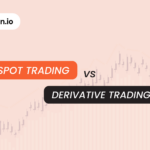Trump’s Tariff War and Its Direct Impact on the Crypto Market
Whenever there is a trade war at the global level, every industry and every market takes a hit. Whether factories, exports, commodities, or more. In fact, such trade wars shake entire financial ecosystems. Recently, US President Donald Trump has been on a tariff war spree. Trump’s aggressive tariff policy, aimed at reshaping global trade, is targeting almost every industry. In fact, it sent ripples across global markets, including crypto.
While many analysts tried to treat crypto as an uncorrelated asset class, Trump’s trade moves exposed how tightly digital currencies tie into global economic sentiment and investor risk appetite.
This article strips away fluff and walks through how Trump’s tariff war pushed crypto markets to react, fall, adapt, and evolve. We will touch base on every element and factor related to the tariff war’s impact on the crypto market and what investors and traders should do in this scenario.
How Crypto Market Reacted Quickly?
The crypto market retaliated sharply. Bitcoin, along with other cryptos, took a dip. It dropped every time global tensions spiked. Let’s look at the numbers:
- On April 7, 2025, following Trump’s threat to reimpose new tariffs on Chinese tech imports, Bitcoin tanked below $75,000. This was a 12% drop from its March average.
- Ethereum followed, falling to around $1,500. So it’s down 50% from February.
- XRP lost 14% in 24 hours.
This mirrored movements in traditional markets. NASDAQ fell 1.9% that same day. Dow Jones shed 560 points. Investors sought liquidity. They exited risk-heavy assets, including crypto. You can imagine how much money was liquidated in the whole!
Now, if you are a crypto investor or a trader, you are surely on the fence. We understand that. Holding on to your investments and assets feels a bit risky at such times. But before you take any step, you should understand what are the short-term and long-term impacts of these tariff wars. So, let’s start with the short-term impact first.
Short-Term Impact on the Crypto Market
The short-term hit to crypto came in three waves: price crash, liquidity crisis, and investor retreat. Let’s break that down.
1. Sharp Price Volatility
Tariff announcements immediately increased volatility. Investors started pulling funds out of high-risk digital assets. Whales and institutional funds dumped positions. Panic sellers followed.
Spot and futures markets saw cascading sell orders. Platforms like Binance triggered mass liquidations across long positions.
2. Loss of Investor Confidence
Retail and mid-tier investors started pulling back from altcoins. They withdrew from speculative tokens and meme coins. Blue chips like Bitcoin and Ethereum saw heavy redemptions. Platforms like Kraken and Gemini reported withdrawal queues stretching over hours.
This drop in confidence reflected fear of a prolonged economic slowdown and stricter financial regulation, especially around foreign transactions.
3. Lower Market Liquidity
As traders hesitated to buy the dip, liquidity dried up. Thin order books caused price swings even with small-volume trades. Exchanges saw a noticeable decline in trading volume over 48 hours after the tariff news.
4. Temporary Rise of Bitcoin as a “Safe-Haven”
Amid the chaos, some Bitcoin maximalists pushed the narrative of BTC as a hedge against fiat devaluation. Bitcoin’s fixed supply made it appealing to those fearing inflation caused by tariffs. Although this didn’t stop the price drop, Google Trends saw a 41% rise in search volume for “Bitcoin safe-haven asset.”
5. Rise in Regulatory Tensions
US regulators increased scrutiny on cross-border crypto transactions. They aimed to stop companies and traders from using crypto to avoid tariff burdens. The IRS and FinCEN had already started auditing large crypto transfers of over $10,000, even before the tariff war began. This auditing will become more intense.
Long-Term Impact on the Crypto Market
While short-term effects are centered on volatility, the long-term consequences will reshape the global role of cryptocurrencies.
1. Surge in Demand for Decentralized Assets
Trade wars push countries toward financial self-sufficiency. This creates distrust between trading blocs. As central banks respond with monetary easing and currency devaluation, investors may prefer decentralized stores of value.
Bitcoin, with its limited supply and protocol-level transparency, stands out as an inflation-resistant asset. In long-term investor portfolios, it can act as a counterweight to government overreach and fiat instability.
2. Clearer Global Regulation
Trade conflicts expose the loopholes in existing financial systems. This pushes regulators to act. Expect a global push toward crypto transparency in trade-related use cases. Governments will introduce tighter Know Your Transaction (KYT) and Cross-Border AML (Anti-Money Laundering) regulations.
The European Commission’s MiCA framework already reflects this shift. The US may follow suit with stricter exchange licensing and stablecoin audits.
Experts believe if digital assets begin to play a role in avoiding trade sanctions or tariffs, regulators will take action. The blockchain doesn’t make transactions invisible. We’re watching closely.
3. Entry of Institutional Capital
Despite volatility, institutional interest remains. Firms like BlackRock, Fidelity, and Ark Invest already manage digital asset funds. As the world fractures into economic blocs, large funds will increase Bitcoin holdings to balance fiat exposure.
As per some analysts, geopolitical risk only accelerates the adoption of decentralized technologies. Institutions will adopt Bitcoin to escape currency politicization.
This sets the stage for more crypto ETFs and regulated products in the next two years.
4. Crypto as a Long-Term Inflation Hedge
Tariffs raise the cost of imports. That pushes up consumer prices. Inflation eats away fiat value. Bitcoin, with no central authority to print more coins, holds appeal as a hedge. Gold and Bitcoin will likely rise together when the fiat weakens.
On-chain analytics platform Glassnode tracked wallet accumulation and noted that long-term holders increased their BTC positions by around 6.3% between March 20 and April 6, 2025—right after the first round of tariff news.
5. Growth in Blockchain-Powered Trade Systems
As traditional trade rails become slower and more expensive due to tariffs and paperwork, blockchain offers alternatives. Smart contract-based logistics, tokenized trade settlements, and DeFi lending protocols will grow.
Trading platforms are already exploring blockchain-based trade infrastructure. The tariff war may speed up this evolution.
What Should Investors and Traders Do
Now, this is the most important part. As an investor or a trader, it’s very important that you track the crypto market constantly. There is a lot of noise, recommendations, and “plans” that you’ll find on the internet about how to deal with this tariff war problem right now.
But to avoid confusion, do not over-exhaust yourself. Here are some of the basic steps experts suggest traders and investors should take.
1, Rebalance and Diversify
Don’t overexpose yourself to a particular crypto. Balance your portfolio with multiple cryptos with dependable technology and a promising future. Also, diversify your portfolio outside crypto. You can add gold, cash, bonds, and defensive stocks to your portfolio. Remember, crypto should serve as a high-growth, high-risk asset and not your entire net worth.
Allocate part of your crypto holdings to stablecoins. They offer good stability, even in the times of turmoil that the crypto market is facing right now. You can use U.S. Treasury-backed stablecoins like USDP or tokenized T-Bills to park funds during turbulent periods.
2, Track Regulatory Developments
Every tariff announcement may carry a crypto compliance clause. So, it’s critical that you keep track of updates from the SEC, IRS, FinCEN, and global bodies. Also, make sure your crypto activity stays clean and transparent.
Use platforms like Visiion.io to keep your crypto taxes and reports in order and stay updated with the market updates.
3: Use Hedging Tools
Protect against the downside using futures and options. You can use Visiion.io’s hedging tools, like derivatives, to protect your crypto portfolio from any wild moves. Learn how to use stop-loss, trailing stop, and limit orders effectively. This will help you take quick action when the market moves against you.
If you are a passive trader, you can allocate some funds to staking. It’s a great way to generate passive wealth without taking the headache of trading. You can stake on Visiion.io easily with a few simple steps.
4: Adopt a Long-Term View
Volatility will dominate headlines. So it’s important that you don’t [pay much attention to the daily noise. If your thesis on Bitcoin, Ethereum, or decentralized tech remains intact, stay invested. Add gradually during dips instead of panic-selling.
Focus on core assets with strong fundamentals. Do not jump on some random meme coins or high-leverage bets. Remember, a good meme coin could prove to be a wealth multiplier. But a bad one can eat your entire corpus within a day. So, only pick a reliable coin from a reliable platform like Visiion.io.
5: Stay Sharp and Vigil
You can use data platforms like Messari, Glassnode, or IntoTheBlock for real-time metrics. You can set up alerts on macroeconomic triggers: Fed announcements, tariff news, and regulatory speeches.
Follow platforms like Visiion.io on LinkedIn, X, YouTube, and Facebook to get the latest updates and regulatory changes in the market. Do not fall for fake news and rumours from unreliable accounts on social sites like Reddit or X. Always verify the information thrice to make sure you are not falling a prey to any fake narrative.
You Can’t Afford to Be Ignorant
Trump’s tariff revival sent shockwaves through global markets. The crypto market obviously is not isolated. There was a mayhem, and there will be some more. But smart investors adapted, repositioned, and stayed in the game.
What’s interesting here is that, in the long run, tariffs may push more people toward decentralized assets. Governments might respond with tighter regulations, but Bitcoin and blockchain tech have crossed the threshold of global recognition. So it’s very important that you, as an investor or a trader, must adapt and adopt discipline.
The crypto market won’t wait. You either move with it or get left behind.










